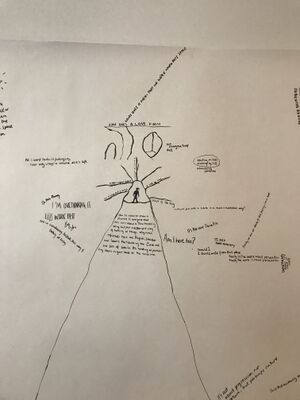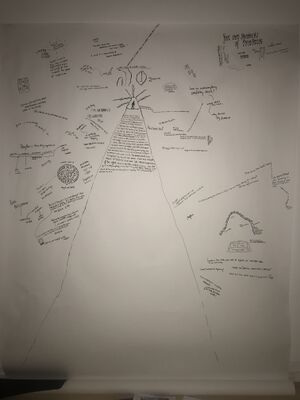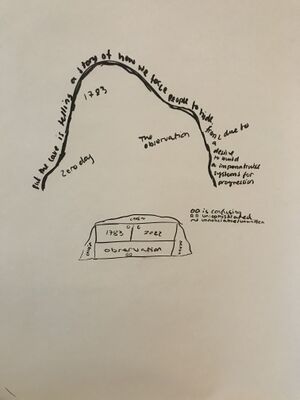TEXT ON PRACTICE 2DRAFT
NOTE: I reference Tom Sachs here alot, this was written before the Curbed article which documented that his studio environment was very unhealthy.
Text On (in) Practice
File:Text-On-Practice-I ve-been-making-what-I-call-wall.ogg *you need to download the extension?
I've been making what I call wall writings, although I'd like to come up with a better name. As it exists now, these are large rolls of paper which are 2m wide. I roll the paper out to just over my head, and I stick this to the wall (with double sided adhesive that doesn't take off the paint on the wall). On these scrolls of paper I practice a number of things: free writing, jotting down ideas on the go, drawing images from current work/future work, writing in shapes/word art, long form essayistic writing, fears/ worries, lyrics, recurring questions, cataloging feedback, drawing shapes of narratives etc. All of these activities come together to form a kind of map.
This map-making has become a way of tracking the progression of thoughts, of eliciting connections, of moving whilst making, of making non-digital work, forming images through words. It stems also from a desire or frustration of communicating connections and ideas I have. It is also a form of simple self expression.
OR
Map making as a way if tracking the progression of thoughts, of eliciting connections, of moving whilst making, of making non-digital work and forming images through word amongst many other things. This act stems from a desire-cum-frustration to reveal the circuitry/wiring between ideas I’ve seen. A process-practice with means to an end but also a form of simple self expression in and of itself. The dual nature of this act is important. More on this later.
I am currently only writing in black ink on white paper. I use specific pens which have a soft felt tip, with an inky feel. I stand, squat or sit on the floor (this is very important). I have not cut the paper yet, but I do intend for there to be an end to this wall writing. Then I will begin another. I would like to create a rolling paper machine from hand, inspired by the artist Van Neistat, he replied to an email I sent him and told me how to make it.
I am editing but showing the edits, making them visible (so far…). When if I begin chastising myself on the page I will edit (leaving the edit visible) suggesting a more open, accepting approach. This is not just for kindness sake, although there is nothing wrong with kindness (kin-ness, Harraway), but these gates and borders that come through chastising are someone else’s standards I have ingested. And this act, and perhaps all of it is about making my own standards of excellence (Tom Sachs).
What are ‘your own internal standards of excellence’? These are protocols to help me function as an artist, these are to be ‘fostered’ (sachs) through the practice. What are the details you attend to? What is that, that moves you in an image? What is your aesthetic standard? What does engagement mean? And…these questions are the seedlings, or the first stitch. Nothing certain yet, will it ever be? More on this later.
A standard I have been exploring through the mapping (and more), is resisting a linear storytelling. The struggle here has always been this. Stories, and I mean ‘once upon a time there was a dog’ kind of stories, Chekov, Saunders, Bilge-Ceylan etc, you know the ones with the beautiful simple (simplicity, simplicity, simplicity - Einstein or maybe (really probably) his wife) structure, the ones that follow a character as they trudge along a straight road of thought and action. Have acted as a great bird, with great soft wings, to lay down upon and now (see!) life is quite beautiful. In other words they have been some of my most vital aids. Here comes the struggle, I am still (and not just for the sake of experimentation or uniqueness) unable to resists a non-linearity, to skip and jolt across time, one brick does not go in front of the other (remember when it was just sand?). There is a political and philosophical resistance (‘fuck linear time, it’s poison’ said the artist Tooth just last week). But, boy does it feel good to travel In The Cart* of Father Time. Perhaps though, the space between these two rocks is not so large…
*"In the Cart" (Russian: На подводе, romanized: Na podvode) is an 1897 short story by Anton Chekhov, also translated as "The Schoolmistress".
With this in mind, and slightly connected is another idea. I am trying to remove how central the finished work is to my practice, these works are destinations where I may arrive at, I circle, I return to but they are contained and do not exist without the roads that led me there, and the roads that don't. And this map making - it helps to stop thinking in a 'I need to make a thing' head space. (To be continued).
I will write a list of my influences so far: Tom Sachs (for his processes and ways of working, specifically 10 bullets), Grayson Perry's (the way he uses mapping and cartography in his illustration specifically thinking of one I saw in a gallery in Eastbourne, its called Map of Nowhere), Olga Tokarczuk (her writing from above, the way she uses maps in her novels and images - non linear, and not just associative, particularly in Book of Jacobs), Pina Baush (for movement, for image), Sayaka Murata (for their unapologetic personal standards of absurdity, mainly her interviews), Iain Mcgilchrist's (writing and philosophical approach to mind and mystery), Karl Diesseroth (for the way he writes and talks about the mind and emotion, his reliance on literature as a scientist), Tarkovsky (it is not linear for sure, nor is it Freudian or Associative but he makes his own perspective). There is also currently a strong influence of medieval word art, Cihad has also shown me some examples from historical Arabic word art. George Saunders is another influence of mine, particuarly his book on writing: A Swim in The Pond In the Rain. I also am influenced by Kendrick Lamar's way of telling stories, specifically in a track called FEAR. It is a story which takes place across generations, with the character of Fear being the link between all the stories. Andre 3000 verse on Blonde (Solo (Reprise), the stream of consciousness, flipping along time). In general storytelling in music, most present in hip-hop and folk music has always been a key influence - if I start writing musicians I will never stop, I mean it. Mamoru Oshii the way they deal with moments in their films. Julie Mehretu, for the way they work with lines and general visual approach, see her album cover for Pharoh Sanders and Floating points, as well as Congress and her show title 'A UNIVERSAL HISTORY OF EVERYTHING AND NOTHING’.
I am pulled along by story and "beauty" and function. Function, this is an important concept in my practice - a relatively new concept. I have begun to understand and perhaps even respect the part of myself that likes to make and study systems, to be pulled into understanding how something functions - what the processes are, under the hood.
With all this said. I also deeply respect mystery and to not look at the finger pointing to the moon, but the moon itself. It's a balance of creating processes and understanding how my practice functions whilst also remembering that not everything is understood or reduced down to functions, that there is always a slither of the infinite that surrounds a work which moves me.
It is important to note that my desire to create protocols and standards for myself as an artist came from a commitment to the profession of being an artist. This is something which is of course important to me on a foundational level, 'the basement that allows the rest of my life to function' (interview from louiassna, writer of the postcard, Anne Berest) but also this is what I will do for my work and there is something very serious about this. I have to find a way to make it stable, something that I can come to every day. I need some kind of map then.
UNEDITED:
I struggle with all the plans, all the ideas, and the inability to act on them all. Sometimes staying too long reveling in the feeling of having an idea. Missing out on action, which is slower, deeper joy(…). This map making is a way of grappling with the rapid flow, I hope though it is not a dam, but more like the narrow moment in a ravine. Which means, I have to be comfortable with the idea that it will always be very fast, some of it momentary. Hmmm. More on this, more on this. What is that analogy, of capturing and letting go at the same time? That’s what this is (has to be). How then, to make sure, after all this, that there is something to engage with - what are you to give to them (you know who they are).
NOTES TO SELF
?Mood (Eggers)?First Principle Cinema?Dyslexia?
Notes before writing this:
What do I want this text on practice to be?
A guide, an understanding, a foundation, something to come back to.
Deeply engaging with the material I have in front of me, mainly ideas.
I struggle with staying, and also staying too long.
Perhaps this work sets out these standards of excellence. Then also talks about mystery. Maps. Influences. Function. Reading habits. Wall Writings. Zero Drafts vs. Script Writing.
Steve suggests amplifying this way of working, how to do this?
——



